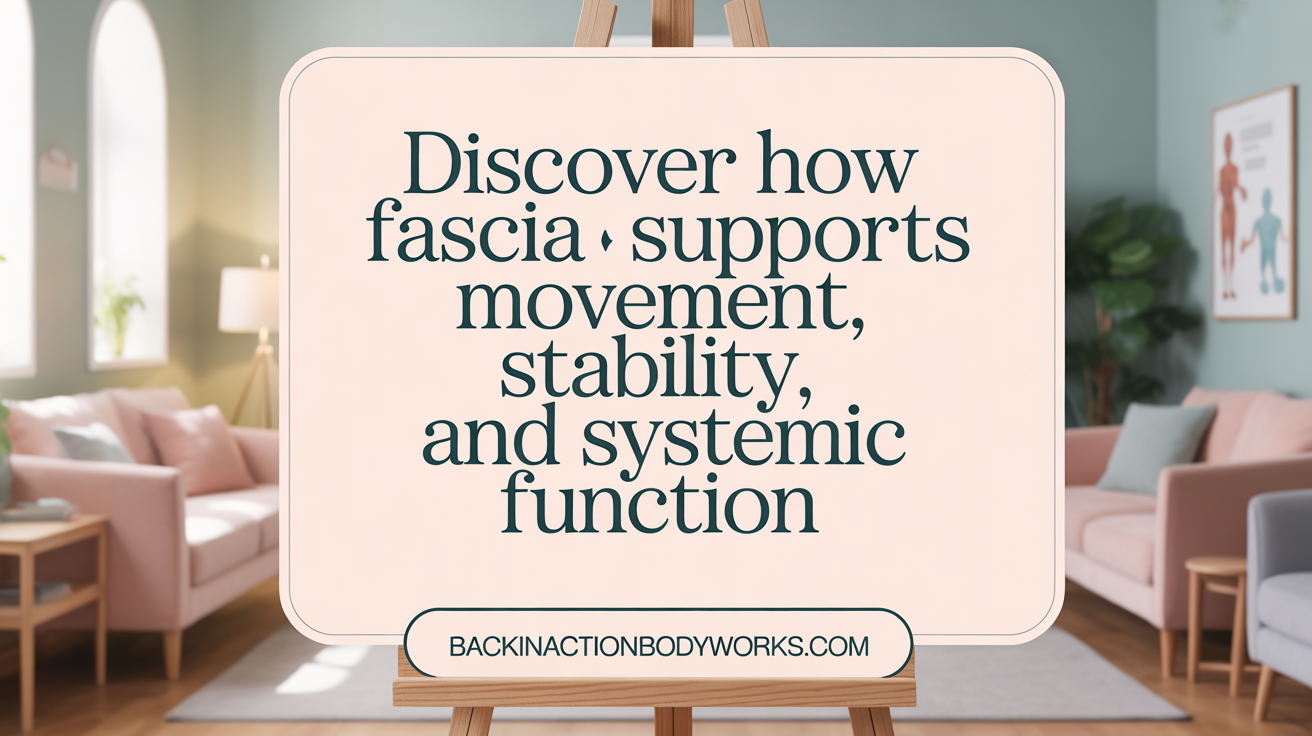Understanding Fascia and Its Role in Physical Function
August 14, 2025
11 min

Unveiling the Fascial System
Beneath the surface of human anatomy lies a complex, interconnected web of connective tissue known as fascia. Often overlooked in traditional anatomy, fascia is fundamental to the body's structural integrity, facilitating movement, supporting organs, and influencing overall health. This article delves into the nature, structure, and multifaceted roles of fascia, shedding light on its significance in physical function and well-being.
Defining Fascia: Nature and Composition
What is fascia in the human body?
Fascia is a continuous web of connective tissue that surrounds and supports every structure within our bodies. It envelops muscles, bones, organs, nerves, and blood vessels, creating a supportive and interconnected network. This tissue acts as the body's 'second skin,' helping to maintain posture, facilitate movement, and absorb mechanical stresses.
Composition of fascia
Fascia is mainly composed of collagen fibers, which lend it both strength and flexibility. It also contains elastin fibers, providing elasticity, and water, particularly hyaluronan, which lubricates tissues and allows them to slide past each other smoothly during movement. The high density of nerve endings in fascia makes it highly sensitive, almost as sensitive as skin.
Basic structure and characteristics
Structurally, fascia is layered. The primary layers include superficial fascia beneath the skin, deep fascia surrounding muscles and bones, visceral fascia around internal organs, and parietal fascia lining body cavities. These layers are rich in fibroblasts, the cells that produce collagen and hyaluronan, helping fascia adapt, remodel, and heal.
Healthy fascia appears smooth, slippery, and elastic, capable of stretching and recoil during physical activity. However, damage from injury, poor posture, or dehydration can cause fascia to become thick, sticky, and restricted, leading to pain and reduced mobility.
Understanding the structure and composition of fascia underscores its vital role in supporting the body's form and function, and highlights the importance of maintaining its health through movement, proper posture, and therapies like massage and stretching.
Anatomy and Types of Fascia: The Body's Connective Layers

What is the anatomy of fascia?
Fascia's anatomy consists of a complex, interconnected web of fibrous connective tissue that surrounds and supports every part of the body. It is mainly made of collagen fibers, which provide both strength and flexibility, allowing the tissue to stretch and recoil as needed. Fascia is organized into four primary layers: the superficial fascia, deep fascia, visceral fascia, and parietal fascia.
The superficial fascia lies just beneath the skin and contains loose connective tissue and fat, offering insulation and protection. The deep fascia encases muscles, bones, nerves, and blood vessels, forming a dense, supportive sheath that aids in movement and force transmission. This layer also contributes to the mechanical coordination of muscles and proprioception. Visceral fascia surrounds internal organs, providing a supportive and protective enclosure, while parietal fascia lines the inner surfaces of body cavities, supporting organs and maintaining containment.
Together, these layers form a three-dimensional network that plays a vital role in biomechanical stability, facilitating movement and systemic functions. Fascia is dynamic; it responds to mechanical stress through remodeling, influencing posture, mobility, and overall health. This connective tissue system also participates in fluid transport, immune response, and nerve signaling, making it an integral part of human physiology.
What are the different types of fascia?
Fascia can be categorized based on its location and function into several primary types:
- Superficial fascia: Located just beneath the skin, this layer mainly contains loose connective tissue and fat. It helps in thermoregulation, cushioning, and venous flow.
- Deep fascia: A dense and fibrous layer that surrounds muscles, bones, nerves, and blood vessels. It provides structural support, enables force transmission, and aids in movement coordination.
- Visceral fascia: Encasing internal organs, this fascia supports and stabilizes organs while allowing necessary mobility.
- Parietal fascia: Lining the walls of body cavities, it helps hold organs in place and maintains cavity integrity.
There are also specialized fasciae, such as the thoracolumbar fascia in the lower back, the fascia lata in the thigh, and the plantar fascia in the foot, each tailored to meet the specific needs of their regions. These various forms of fascia work collectively, supporting movement, protecting tissues, and contributing to bodily functions such as circulation and neural communication. Maintaining the health of these layers through activity, stretching, and manual therapies ensures optimal support and function of the overall fascial system.
Core Functions of Fascia in Movement and Support

What are the main functions of fascia?
Fascia is a vital connective tissue that performs several crucial roles throughout the body. Its primary function is to provide support and stability, enveloping muscles, organs, bones, nerves, and blood vessels. This supportive web maintains the body's structural integrity, helping us stand upright and move efficiently.
Fascia also facilitates movement by creating a slippery, elastic environment for tissues to slide against each other smoothly. This reduces friction and allows muscles and other tissues to glide seamlessly during motion, which is essential for flexibility and coordinated activity.
Force transmission and elasticity are other critical roles of fascia. It acts as an energy-storing and force-transmitting medium, supporting the mechanical transmission of force across muscle groups. Its elastic properties enable it to withstand deformation and recover its shape, contributing to movement efficiency and resilience against mechanical stresses.
Moreover, fascia is heavily innervated with sensory receptors, making it a key player in proprioception—the body’s sense of position and movement. It helps in perceiving posture, balance, and movement, while also being involved in detecting pain and discomfort.
Beyond supporting movement, fascia contributes to fluid dynamics in the body. It contains hyaluronan, a liquid that acts as a lubricant for tissues, aiding in blood and lymph circulation, tissue nourishment, and waste removal. This allows for healthy tissue function and resilience.
In response to mechanical stress, fascia can remodel—becoming more flexible or, if overused or injured, thickened and restricted. This adaptability helps the body recover from stress and maintain optimal function.
In essence, fascia is much more than a passive support structure. It actively supports movement, transmits forces, aids proprioception, and helps regulate systemic health. Understanding its roles underscores the importance of maintaining fascia health through movement, proper posture, and therapy interventions.
Key Characteristics and Mechanical Properties of Fascia
What are the four key characteristics of fascia?
Fascia is a vital connective tissue that surrounds and supports every part of the body. Its four main features include its structure as a sheath or sheet of connective tissue, mainly composed of collagen fibers. This composition makes fascia both strong and flexible, allowing it to endure mechanical stresses and stretch without damage.
Fascia extends into a three-dimensional network that envelopes muscles, organs, nerves, and blood vessels, establishing continuous support and facilitating movement. It acts not only as a structural component but also as a communication system, containing a high density of nerve endings and mechanoreceptors. These sensory elements enable fascia to participate actively in proprioception, pain perception, and systemic regulation.
Furthermore, fascia is adaptable. It can respond to various stimuli—such as trauma, inflammation, or emotional stress—by becoming tighter, thicker, or more relaxed. These changes directly influence posture, mobility, and overall tissue health, demonstrating fascia’s dynamic nature and its integral role in maintaining bodily functions.
Fascia and Inflammation: Understanding Fasciitis and Related Conditions

What is inflammation of the fascia called?
Inflammation of the fascia is known as fasciitis. This condition can occur in various parts of the body and stems from different causes such as overuse, injury, infection, or autoimmune responses. There are several types of fasciitis, each affecting different fascia tissues.
For example, plantar fasciitis is a common form where inflammation occurs in the fascia supporting the arch of the foot. Necrotizing fasciitis is a severe bacterial infection that rapidly destroys fascia and surrounding tissues, requiring urgent medical attention.
A rare autoimmune disease called eosinophilic fasciitis involves inflammation, swelling, and thickening of the fascia, generally impacting the arms and legs. These conditions often present with symptoms like pain, swelling, and tissue hardening. Recognizing fasciitis early and administering appropriate treatment, such as anti-inflammatory medications, are crucial to managing symptoms and preventing further tissue damage.
Types of fasciitis and examples
| Type of Fasciitis | Affected Area | Typical Cause | Symptoms | Clinical Notes |
|---|---|---|---|---|
| Plantar fasciitis | Foot (plantar fascia) | Overuse, excessive walking or standing | Heel pain, especially in the morning | Most common in runners and athletes |
| Necrotizing fasciitis | Deep fascia (any area) | Severe bacterial infection | Rapid tissue death, severe pain, fever | Requires urgent surgery and antibiotics |
| Eosinophilic fasciitis | Limbs, arms, legs | Autoimmune response | Stiffness, swelling, skin thickening | Often misdiagnosed; responds well to steroids |
| Myofascial fasciitis | Muscles and surrounding fascia | Trauma, overuse | Chronic pain, trigger points | Involves myofascial pain syndrome |
Symptoms and clinical significance
Fasciitis manifests through symptoms such as persistent pain, swelling, tenderness, and in some cases, tissue hardening or nodules. These signs often impair movement and can lead to chronic discomfort if not properly treated.
Clinically, fasciitis is significant because it may mimic other joint or muscular conditions, making accurate diagnosis important. If ignored, inflammation can cause fibrosis or adhesions, restricting tissue movement and leading to further pain and dysfunction.
Addressing fasciitis typically involves anti-inflammatory therapies, rest, physical therapy, and in some cases, surgical intervention. Maintaining fascia health through regular stretching, activity, and good posture is also vital for prevention.
More information search query: fasciitis inflammation types symptoms
This understanding emphasizes the importance of recognizing fasciitis promptly to facilitate effective management and recovery.
Signs of Unhealthy Fascia and Impacts on Physical Function

What does unhealthy fascia feel like?
Unhealthy fascia often presents with sensations of tightness, stiffness, and restriction. People may notice a heaviness or decreased flexibility in the affected regions. This can manifest as deep, aching muscle pains or tender knots known as trigger points inside muscles. Such discomfort tends to intensify during movement or stretching, making activity challenging.
Individuals might also experience a dull, persistent soreness and heightened sensitivity when pressing on tight muscles. In more severe cases, the fascia and underlying tissues can become inflamed, leading to localized or even referred pain in other areas. These symptoms are usually accompanied by muscle tenderness, a diminished range of motion, and feelings of fatigue.
All these signs indicate that the fascia is compromised—no longer able to support properly or glide smoothly against adjacent structures. This deterioration hampers normal movement patterns, contributing to functional impairments and discomfort that can significantly affect daily activities.
Maintaining and Training Fascia for Optimal Health

How can fascia be trained or maintained for better health?
Fascia, the connective tissue web that supports and surrounds every part of the body, benefits from consistent movement and targeted exercises. Engaging in dynamic stretching routines, such as yoga or mobility drills, can help keep fascia supple, elastic, and responsive. These activities encourage the fascia to stretch and adapt, preventing stiffness and adhesions that lead to pain.
Incorporating plyometric exercises like hopping, skipping, or explosive jumps can also strengthen the fascial tissues. These high-impact, multi-directional movements stimulate tissue resilience by enhancing elastic recoil, which is essential for efficient movement and injury prevention. Over time, such training can improve fascial integrity and support better posture.
Manual therapies like foam rolling and myofascial release techniques further promote healthy fascia. They work by breaking up adhesions, increasing tissue mobility, and reducing areas of tightness and trigger points. These methods, combined with active movement, help maintain optimal fascial function and prevent restrictions.
Supporting fascia health also involves proper hydration and nutrition. Drinking sufficient water keeps hyaluronan, the fluid that allows fascia to stretch, properly lubricated. Consuming collagen-rich foods, bone broth, or supplements can aid in repairing and strengthening connective tissues.
A well-rounded approach that combines movement, manual therapies, and healthy habits can dramatically improve fascia's ability to support movement, reduce pain, and enhance overall body function.
Emotional and Trauma-Related Influences on Fascia
Can emotions be stored in fascia?
Fascia acts as an emotional reservoir in the body. Negative feelings such as grief, anger, anxiety, or stress can leave somatic imprints within the fascial network, sometimes described as "scar-like" marks. When emotional tension builds, often due to unresolved trauma or chronic stress, fascia tends to tighten or become restricted. These restrictions can interfere with normal movement, causing stiffness, pain, and postural imbalances.
The connection between emotions and fascia extends beyond physical sensation. Emotional energy stored in fascia can influence neurological pathways and biochemical responses, perpetuating a cycle of tension that impacts overall health. For example, persistent emotional stress may lead to fascial stiffening, which in turn contributes to chronic pain conditions, headaches, or emotional imbalance.
Techniques like osteopathic manipulation, myofascial release, or somatic therapy are effective in releasing these hidden tensions. They help restore the fascia’s natural elasticity and integrity, addressing both physical and emotional layers of discomfort. Recognizing fascia as an active conduit for emotional energy underscores the importance of holistic treatment approaches in healing.
Overall, fascia functions as more than just a support structure—it's a vessel for emotional energy. When these emotional imprints are addressed with gentle, mindful practices, physical restrictions often reduce, facilitating emotional release and enhanced well-being.
How can trauma be released from fascia?
Trauma stored in fascia can be effectively released through gentle, mindful practices that promote awareness and bodily sensing. Techniques such as fascia-specific massage, myofascial release, and embodiment exercises help clients tune into their tissues, encouraging movement and release.
Mindful breathing exercises, especially those engaging the vagus nerve, can shift the nervous system from stress mode (sympathetic dominance) into states of safety and relaxation (parasympathetic dominance). Practices like vagus nerve yoga, slow eye movements, and gentle stretching stimulate neural pathways that aid in calming the fascia and reducing tension.
Embodiment techniques—such as grounding, body scans, and guided imagery—help individuals connect with their bodily sensations without judgment, facilitating the release of deep-seated emotional and physical tension. These techniques stimulate the vagus nerve, enhance nervous system regulation, and help the fascia regain its natural suppleness.
Addressing unresolved trauma through somatic awareness prevents fascia from becoming sticky, hardened, or overly restrictive. Combining nervous system nourishment—rest, breathing, grounding—with gentle movement promotes tissue hydration, elasticity, and overall peace. This holistic approach supports the gradual release of trauma embedded within the fascial system, leading to greater physical mobility and emotional resilience.
The Integral Role of Fascia in Health and Movement
Fascia is far more than just connective tissue; it is an essential, dynamic organ that underpins bodily structure, movement, and physiological function. From its complex multilayered anatomy to its capacity to transmit force, facilitate fluid dynamics, and modulate sensory input, fascia is central to our physical and emotional well-being. Recognizing its role not only improves understanding of many pain and mobility disorders but also opens new avenues for treatment and health maintenance. Through mindful movement, targeted therapies, and holistic care, maintaining healthy fascia enhances mobility, reduces pain, and supports overall vitality, reinforcing the profound interconnectedness of body and mind.
References
- Fascia Tissue Function - Cleveland Clinic
- Anatomy, Fascia - StatPearls - NCBI Bookshelf
- Muscle Pain: It May Actually Be Your Fascia - Johns Hopkins Medicine
- Fascia - Physiopedia
- Understanding The Fascial System: An In-Depth Exploration
- Understanding Fascia and the Role It Plays - Stretch 22
- Fascia as a regulatory system in health and disease - Frontiers
Recent articles

Chiropractic Care: Key Benefits for Managing and Preventing Back Pain

Corrective Exercises That Support Long-Term Relief from Sciatica

Chiropractic Methods That Provide Lasting Relief from Back Pain

Understanding Spinal Decompression and Its Benefits for Sciatica

Real Patient Testimonials: Success Stories in Chiropractic Care

Top Questions to Ask Your Chiropractor During Your Initial Visit

Physiotherapy's Role in Supporting Chiropractic Treatment Plans

The Role of Diet and Nutrition in Enhancing Wellness and Chiropractic Care

Inspiring Patient Testimonials Highlighting Chiropractic Success

Chiropractic Care: A Natural Solution for Back Pain Relief

Amazing Patient Success Stories in Chiropractic Wellness

Combining Physiotherapy and Chiropractic for Optimal Healing

Spinal Decompression Therapy: A Breakthrough for Sciatica Sufferers

5 Holistic Treatments That Complement Chiropractic Care

How Physiotherapy Supports and Enhances Chiropractic Treatment

Root Cause Versus Symptom Treatment: Making the Right Choice

7 Essential Things to Know Before Choosing Your Chiropractor

Why Addressing Root Causes of Pain Matters More Than Just Symptoms

Nutritional Counseling Strategies to Boost Your Overall Wellness

How Spinal Decompression Therapy Alleviates Sciatic Nerve Pain

Long-Term Pain Relief Through Targeted Corrective Exercises

10 Benefits of Integrating Physiotherapy with Chiropractic Treatments

Corrective Exercises That Help Prevent Recurring Pain

8 Corrective Exercises Proven for Lasting Pain Relief

Lifestyle Habits for Maintaining a Healthy Spine

What You Will Experience at Your Initial Chiropractic Visit

What Happens at Your First Visit to a Chiropractor?

Focusing on Root Cause Analysis for Effective Pain Relief

Tips for Lifestyle Changes to Support Spinal Health

Tips for Lifestyle Changes to Support Spinal Health

Holistic Treatment Plans: Alternatives to Surgery for Chronic Pain

Enhance Wellness Through Personalized Nutritional Counseling

Non-Invasive Pain Relief: Exploring Holistic Treatment Alternatives

Sciatica Relief Through Targeted Spinal Decompression

Integrating Physiotherapy with Chiropractic Treatments for Better Results

Testimonials That Demonstrate the Benefits of Chiropractic Care

The Power of Corrective Exercises in Pain Management

A Step-by-Step Guide to Your Initial Chiropractic Consultation

9 Nutritional Tips to Enhance Your Chiropractic Wellness Journey

Patient Experiences: How Chiropractic Care Changed Their Lives

Lifestyle Recommendations to Keep Your Spine in Top Shape

Effective Corrective Exercises for Long-Term Pain Relief

Back Pain Benefits: What Chiropractic Care Can Do for You

Spinal Decompression Techniques for Effective Sciatica Relief

Top Nutritional Counseling Tips for Enhanced Wellness

6 Lifestyle Habits That Boost Spine Health Daily

Discover Holistic and Non-Surgical Pain Relief Solutions

Exploring Holistic and Non-Surgical Treatment Options for Pain

The Role of Physiotherapy in Enhancing Chiropractic Care Outcomes

Complementing Chiropractic Care with Physiotherapy: What You Need to Know

What to Expect During Your First Chiropractic Visit

Simple Lifestyle Adjustments to Maintain a Healthy Spine

Personalized Nutritional Counseling for Improved Health Outcomes

Exploring Non-Surgical Treatments for Spine-Related Conditions

An Introduction to Spinal Decompression for Sciatica Patients

Transformative Success Stories: Patient Experiences with Chiropractic Treatments

Why Chiropractic Care Is Essential for Back Pain Relief

Addressing Underlying Causes Versus Symptom Management in Pain Care

The Role of Nutrition in Enhancing Chiropractic Treatment Effectiveness

Sciatica Treatment Options: Is Spinal Decompression Right for You?

Lifestyle Tips to Maintain a Healthy Spine and Prevent Back Issues

The Synergy Between Physiotherapy and Chiropractic Treatments

What Happens During Your Initial Chiropractic Consultation

Effective Corrective Exercises for Sustainable Pain Management

Taking a Root Cause Approach to Chronic Pain Management

Holistic Pain Management Techniques Without Surgery

How Patient Success Stories Validate Chiropractic Care Benefits

Spinal Decompression: Innovative Treatment for Sciatic Nerve Pain

Spinal Decompression Therapy: A Non-Invasive Approach to Sciatica Relief

Exploring Holistic Approaches Beyond Surgery for Pain Relief

Practical Lifestyle Advice to Support a Healthy Spine Every Day

Corrective Exercise Routines Designed for Long-Term Pain Prevention

Real Patient Stories: Overcoming Chronic Pain with Chiropractic Care

Lifestyle Changes That Promote a Healthy Spine and Prevent Injury

How Addressing the Root Cause of Pain Leads to Lasting Relief

Non-Surgical Holistic Therapies to Manage Chronic Pain Effectively

Nutritional Counseling's Impact on Physical Health and Healing

Benefits of Regular Chiropractic Care for a Stronger Back

Your First Chiropractic Visit: What to Expect and How to Prepare

Patient Experiences: How Chiropractic Care Transformed Their Lives

Exploring Holistic, Non-Surgical Options for Pain Management

Combining Physiotherapy with Chiropractic Treatments for Enhanced Recovery

Holistic Treatments That Offer Alternatives to Surgery for Pain Relief

Corrective Exercise Strategies for Long-Term Spine Health

How Physiotherapy Complements Chiropractic Adjustments for Better Outcomes

First-Time Chiropractic Visitors: What You Should Know

Understanding the Importance of Treating Pain at Its Source

Adopting Lifestyle Changes to Support Your Spine's Wellness

Utilizing Physiotherapy to Enhance Chiropractic Treatment Outcomes

The Key Advantages of Chiropractic Care for Back Pain Sufferers

Why Focusing on Root Causes Improves Pain Treatment Success

Corrective Exercises That Promote Lasting Pain Relief and Mobility

Sciatica Relief Through Targeted Spinal Decompression Techniques

Preparing for Your First Chiropractic Appointment with Confidence

Healthy Lifestyle Habits for Maintaining Spinal Alignment

Success Stories Highlighting Chiropractic's Role in Pain Recovery

Top Benefits of Chiropractic Care for Chronic Back Pain

Nutrition Tips to Boost Your Overall Wellness and Recovery

How Chiropractic Care Alleviates Back Pain Naturally

